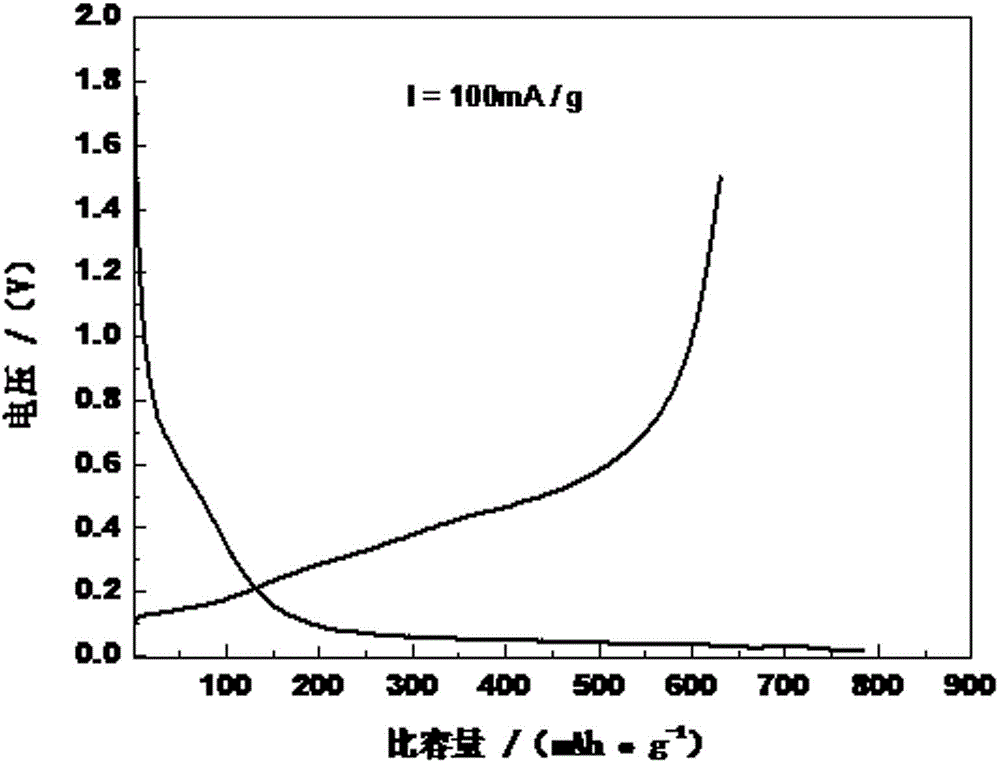Method for preparing Si/C/graphite composite negative electrode material
A negative electrode material and graphite technology, which is applied in the field of preparation of silicon-based composite materials for lithium-ion batteries, can solve the problems of lithium ion consumption, high cost of nano-silicon, electrode pulverization failure, etc., to improve cycle stability, improve conductivity, The effect of suppressing pulverization failure
- Summary
- Abstract
- Description
- Claims
- Application Information
AI Technical Summary
Problems solved by technology
Method used
Image
Examples
Embodiment 1
[0026] Weigh 100 g of micron silicon powder with an average particle size of 1.5 μm, and mix them uniformly with 50 g of glucose, then add 500 mL of deionized water, and mill the mixture in a high-energy ball mill for 3 hours to obtain a uniformly dispersed nano-silicon mixture.
[0027] Mix the above mixture with 100g of natural spherical graphite negative electrode material with an average particle size of 12μm, add 500mL of deionized water, and stir for 0.5 hours; adjust the spray drying inlet temperature to 300°C, and the outlet temperature to 120°C, and spray dry to obtain a spherical Particle precursor; under the condition of nitrogen atmosphere and 600°C, the precursor was calcined for 6 hours, cooled to room temperature, and then crushed to obtain Si / C / graphite negative electrode material.
[0028] Using the Si / C / graphite negative electrode material prepared in Example 1, conductive carbon black, and CMC and SBR binders in a mass ratio of 80:10:4:6, deionized water was ...
Embodiment 2
[0031] Weigh 100 g of micron silicon powder with an average particle size of 5 μm and 80 g of sucrose and mix evenly, then add 1000 mL of deionized water, and mill the mixture in a high-energy ball mill for 6 hours to obtain a uniformly dispersed nano-silicon mixture.
[0032] Mix the above mixture with 120g of natural spherical graphite negative electrode material with an average particle size of 20μm, add 200mL of absolute ethanol, and stir for 2 hours; adjust the spray drying inlet temperature to 250°C, and the outlet temperature to 100°C, and spray dry to obtain a spherical Particle precursor; under the condition of nitrogen atmosphere and 800°C, the precursor was calcined for 8 hours, cooled to room temperature, and then crushed to obtain Si / C / graphite negative electrode material.
[0033] The experimental button cell was fabricated in the same manner as in Example 1.
[0034] As shown in Table 1, the experimental button battery made of the material of Example 2 has a spe...
Embodiment 3
[0036] Weigh 100 g of micron silicon powder with an average particle size of 1 μm, and mix them uniformly with 10 g of polyvinyl alcohol, then add 500 mL of absolute ethanol, and mill the mixture in a high-energy ball mill for 2 hours to obtain a uniformly dispersed nano-silicon mixture.
[0037]Mix the above mixture with 100g of natural spherical graphite negative electrode material with an average particle size of 25μm, add 500mL of absolute ethanol, and stir for 2 hours; adjust the spray drying inlet temperature to 350°C, and the outlet temperature to 150°C, and spray dry to obtain spherical graphite Particle precursor; under the condition of nitrogen atmosphere and 800°C, the precursor was calcined for 4 hours, cooled to room temperature, and then crushed to obtain Si / C / graphite negative electrode material.
[0038] The experimental button cell was fabricated in the same manner as in Example 1.
[0039] As shown in Table 1, the experimental button battery made of the mater...
PUM
| Property | Measurement | Unit |
|---|---|---|
| The average particle size | aaaaa | aaaaa |
| The average particle size | aaaaa | aaaaa |
| The average particle size | aaaaa | aaaaa |
Abstract
Description
Claims
Application Information
 Login to View More
Login to View More - R&D
- Intellectual Property
- Life Sciences
- Materials
- Tech Scout
- Unparalleled Data Quality
- Higher Quality Content
- 60% Fewer Hallucinations
Browse by: Latest US Patents, China's latest patents, Technical Efficacy Thesaurus, Application Domain, Technology Topic, Popular Technical Reports.
© 2025 PatSnap. All rights reserved.Legal|Privacy policy|Modern Slavery Act Transparency Statement|Sitemap|About US| Contact US: help@patsnap.com



